Myths of Tsushima
Dear readers, this material is a response to the articles of Alexander Samsonov and Oleg Kaptsov, dedicated to the Tsushima battle. To my deep regret, in articles by respected authors, we again (for the umpteenth time!) Read about the “bad preparation of Russian commanders,” “overloaded with coal battleships”, “unintelligent Russian command” and other myths of Tsushima that were rooted in the public consciousness.
Huge problem historical science consists in the existence of the so-called “folk history” - a story for the masses that gravitates towards simple and understandable interpretations of past events, but which has very little in common with a real, real history. One example of the Volks-Histori is precisely the generally accepted interpretation of the Tsushima battle. There is a historically reliable fact - the Russian squadron underwent a terrible defeat, failing to inflict the opposing Japanese the fleet not that of equal, but at least any significant losses. This fact is undeniable. The lost battle stirred our compatriots, the society demanded an answer to the question: “How could this happen? Who's guilty?!" And the answers were found ... Simple, understandable and therefore having very little in common with reality. Real life is much more complex and multifaceted fourth-grade history textbook.
What do we read from year to year in articles and materials devoted to Tsushima? Yes, in fact, the same thing - the sad story of how untrained crews, recruited from the forest and from the pine, diluted with penalty boxes (where they were not) were sent directly into the mouth of the over-trained and "super-alloyed" Japanese fleet. At the same time, the talentless satrap-tyrant was put at the head of the Russian army, experiencing a completely unhealthy craving for coal, breaking thousands of binoculars about the heads of their subordinates, but completely unable to figure out that the squadron entrusted to its care should have been trained a little before the battle. And of course, this satrap, meeting face to face with the Japanese superhero commander, fell into complete prostration and lost the battle with a crushing score. All clear!
Without claiming the ultimate truth at all, I will try to present some facts and considerations that significantly change our picture of the campaign and battle of the Second Pacific Squadron. I hope that even those who disagree with my interpretation of those distant events (and there will be many of them, I do not doubt it) will understand, however, that the reasons for the defeat of the Russian squadron are much more complicated than we used to consider.
On the preparation of Russian gunners
Typically, sources write the following: before the war, the Russian fleet commanders learned to shoot 7-10 cables (and 25 KBT was already considered a very large distance), but the Second Pacific did not have time to go through a normal course of combat training. Its commander, Admiral Rozhestvensky, did not organize shooting training in the march, as a result, in battle, the level of our gunners was lower than the lowest. Alexander Samsonov writes:
But what is interesting is that it is generally accepted that the preparation of the First Pacific Squadron, based in Port Arthur, was at a quite satisfactory level. Let's look at the results achieved by it. 28 July 1904 in the battle of Shantung, which took place when Vitgeft led the Russian squadron on a breakthrough, 32 (or 33, one unreliable hit) of all calibres, including those not installed, got into the Japanese ships. Under Tsushima, Mikado ships suffered much more - according to N.J.M. Campbell’s article “The battle of Tsushima” from Warship International (1978, part of 3), ships of the first and second armored units (i.e., 12 battleships and armored cruisers of the main forces) received 156 hits. The total number of hits on Japanese ships was, according to the "Surgical and medical description of the sea war between Japan and Russia." (Tokyo Medical Department Maritime Bureau - 1905. "" About 117 shells with a caliber of 120 mm and above and about as many calibers ". Ie more than 230 hits!
These figures alone make one seriously doubt the thesis about the allegedly poor training of the Russian 2-th Pacific artillerymen. And if we try to dig a little bit, then we will be completely surprised by the colossal difference in the level of 1-th and 2-Pacific squadrons.
The battle at Shanthung consisted of 2 phases of about an hour of each 2. The first phase of the battle began at a distance of 70 or even 80 KB, and closer to 45-50 KB, the ships of the opposing sides did not converge (although there are references to the distance 45-50 KBT as the average firing distance, but this is most likely a mistake). The second phase is much more interesting - in it the commander of the Japanese fleet of Togo was substituted in full. Forced to catch up with the Russian squadron (which for some reason he had missed by himself before), he set up his flagship Mikas just opposite the middle of our formation. As a result, all 6 Russian battleships could shoot at Mikas. Judging by the number of hits (out of the total number of 32-33 hits on Japanese ships, Mikasa accounts for 24), the Russians tried to take advantage of this. Conditions for the fight were very good - the weather was calm, there was no excitement. And the distance for the Russian sailors was more familiar - the battle began approximately from 40 KB (perhaps 45 KB), by the end of the battle, the parties moved closer to 23 KB. Shoot - I do not want! However, in about 3,5-4 hours of war, six Russian battleships were able to achieve just a little more than three dozen hits.
In the start of the Tsushima battle, only five Russian battleships and, perhaps, Navarin could shoot at Mikas.
But we must remember that the “Eagle” joined the battle with a delay, besides, “Mikasa”, turning around, went across the path of the Russian squadron, and our battleships could not shoot at it all overboard - only part of the guns fought. The distance was relatively small - 37-38 KBT, but the excitement is so strong that the Japanese did not consider it possible to use their destroyers (they brought them out later, towards evening), so that the aiming of the guns was difficult.
However, according to information from the report of Captain Packinham, a British observer stationed at Asahi, within fifteen minutes of the start of the fight, from 14: 10 to 14: 25, Mikasa received NINETAYED hits - five 12 "and fourteen 6" shells. Another six hits were other Japanese ships.
A small remark: Japanese time differs from that indicated by the Russians on 20 minutes, since the Japanese counted the time on the Kyoto meridian, and on the Russian squadron on the meridian of the midday place before the battle, so the above Japanese time corresponds to Russian time: 13: 50 - 14: 05.
So, the experienced Pacific first commanders under the command of Witgeft took almost 4 hours to hit the 24 Mikas with shells. And Rozhestvensky's “lumpsters”, who were in much worse conditions (an unfavorable angle, because of which part of the guns could not shoot, were very excited) for 19 hits, it took 15 minutes. Something here ends meet somehow wrong ...
So how did the Russian Second Pacific commanders train? A word to the senior officer of the battleship "Eagle", captain of 2 rank Schwede:
Stop, stop, stop. So, did the 2 Pacific ships still do practical shooting before going on the march? And not just fulfilled, but also “almost finished” them in 20-s of September? So it is, testifies Schwede:
And what about the "Eagle"?
But let's not interrupt the testimony of the Swedes, given to them by the Investigation Commission for the Tsushima battle:
All on battleship "Orel" was made extra ammunition for practical shooting over state 40 305-mm, 180 152-mm, 300 75-mm, 1 500 47-mm and 2 850 37-mm practice shots, but only 4 870 training projectile . Of these, 40 305-mm shells were spent, and from other 2 / 3 shells. Total goes 3260 shells.
And how did the Japanese prepare for the meeting with Rozhestvensky? Thanks to some Japanese pranksters, a bike about five ammunition charges, allegedly fired from each Japanese gun, went for a walk, after which these guns themselves were replaced with new ones.
I do not reproach Vladimir Ivanovich Semenov at all, it simply repeated what I heard. But after all, the guns of those times could hardly withstand the execution of "five ammunition" - but even if it were so, all the same, by the end of such a shooting, the guns would have become utterly worthless. And where would Japan take hundreds of guns to replace them for the entire fleet?
According to the report of captain T. Jackson, at the spring 1905 of the Mikasa shooting practice, he fired 8 (EIGHT) main caliber projectiles. (The battleship "Eagle" released them 40). And there were no other caliber firing from the Japanese battleship. The rest of the time, the Japanese were entertaining themselves with stun guns, and that’s that. In total, according to Japanese documents, "Mikasa" fired over 9 thousands of bullets and projectiles, imitating the shooting of medium and large-caliber guns. According to the Eagle, there are no such data, but there is a reasonable assumption that at least 8 thousands were spent by rifle bullets alone, and that is not counting the shells of other calibers that we calculated above 3260.
Interesting ... The Russian squadron went through a full course of artillery preparation before it was sent, i.e. The commander graduates of the training detachment, where they were taught to shoot from quite decent guns of our coastal defense battleships Ushakov, Senyavin and Apraksin, were assigned to the newest warships, and there they were still shooting for weeks at 2-3. Well, and those ships that did not have time to fire, loaded with training shells to get their norm in the campaign. At the same time, according to Shwede, the intensity of the shooting was such that all stocks of training shells of the 2 Pacific squadron were shot.
Already this alone considerably changes the perception we are used to by the Russian commanders of the 2 Pacific squadron, whom we are accustomed to regard as a crowd of untrained men from a plow. The Japanese were preparing for a meeting with our ships and were preparing quite intensively, but the Russians (comparing the consumption of projectiles and cartridges from the Eagle and Mikasy) organized an even more intensive training. And this is despite the fact that the Russian squadron, in fact, was on the march, while the Japanese were at their bases.
And now let's look at it also from which side: what did the admiral have to think about all this? Everything seems to be in order, the “course of the young fighter” has been passed, and such an ordinary commander as we used to think of Zinovy Petrovich Rozhestvensky clearly had to be satisfied with this. The squadron is ready to fight with the Japanese!
Here are just Z.P. Rozhestvensky considered "a little" different. The admiral was convinced that the training received by his gunners was categorically insufficient and he DEMANDS for his ships additional training shells. The word shvede:
All that was available in the warehouses, Rozhestvensky loaded onto his ships and spent (the remnants of the Orel truth remain a mystery, however, quite understandable), and additional shells (which were just to be produced) were to be delivered to the squadron Irtysh. But someone particularly wise from under the spitz decided that it would be better if these shells would wait for the squadron in Vladivostok - and sent them by rail, so that the "Irtysh" joined the fleet with only a load of coal ...
Bitter reproach comes through in the answers of Z.P. Rozhdestvensky representatives of the Investigation Commission:
The navy ministry could with sufficient accuracy answer the question whether there was a possibility of additional supply of the second squadron with combat reserves for practice in shooting while sailing and to indicate what was being done for this.
I was promised to send in combat along the Irtysh transport combat reserves for shooting training, but after the squadron sailed from the Baltic Sea, the reserves received from the factories received a different purpose.
Rozhdestvensky's critics love to talk about the following: you can release both 100 and 200 shells into a fixed shield standing in the 10 cable from the gun, but this does not teach the commander to hit the enemy going to 14 from the 40-70 cable distance. How many reproaches were made to Admiral Rozhestvensky about this! After all, he could appreciate the increased range of artillery combat, could organize the training of his gunners in relation to new realities, could ... but did not, and therefore blame.
And it was not known to the gentlemen who criticized the admiral, how, in fact, the teachings of Zinovy Petrovich were organized. A word to the senior artillery officer of the battleship Sisoy the Great, lieutenant S. A. Malechkin:
Apparently, Rozhestvensky was the first in the Russian fleet to organize shooting training at such ranges.
The opinion about the disgusting training of Russian artillerymen and the lack of talent of the commander of the 2 Pacific squadron, who failed to organize training for the personnel entrusted to him, is as widespread as it is mistaken. In fact, everything was exactly the opposite - the sailors made every effort to prepare the squadron for the march and battle. Admiral Rozhestvensky not only sanctioned the unprecedented intensity of the training of artillerymen, scraping stocks of training shells to dryness, but also, having managed to understand the changed realities of the naval war, organized the training of 2 of the Pacific Squadron in the march as it had never been in the Russian fleet. And the Russian sailors shot at Tsushima very well.
Unfortunately, it is absolutely impossible to derive the percentage of hits for each side. Just because, knowing the number of hits in the Japanese ships, we do not know how many shells were fired by the Russian ships - many of them died, and the cost of the shells would never be known to anyone. At the same time, the consumption of projectiles in Japanese ships is known, but the number of hits is not, since we estimate how many shells hit Suvorov, Alexandra, Borodino, etc. we can not. And yet some conclusions are possible.
Russian squadron battleships had a hefty problem - the low rate of fire of the 305-mm Obukhov guns. They fired once a minute and a half, or even less, while Japanese 305-mm could shoot every 40-50 seconds. Subsequently, this lack of Russian artillery was corrected, but it happened after the Russian-Japanese war, and then ... In the battle at Shantung, four Japanese battleships fired 603 305-mm projectile, or approximately 150 shells on the ship, while the four Russian equipped with 12-inch artillery ("Tsesarevich", "Retvisan", "Poltava", "Sevastopol") - only 344 (on average 86 per battleship), and this despite the numerous ruptures of the barrels of Japanese guns, significantly reduced fire performance (to the end of the battle for this reason Japanese 5 305-mm guns from 16 failed. In Tsushima, the consumption of Japanese shells was significantly less - 446 shells or roughly 111 shells per battleship, although it should be borne in mind that this is the total consumption of shells and 14 and 15 in May. And how many shells fired Russian battleships?
Kostenko, indicated in his memoirs that in the morning of May 15 there were 52 305-mm projectiles in the bow cellars, four more (two armor-piercing and high-explosive) in the stern cellar. A total of 240 305-mm and 40 training shells were loaded onto the Eagle. Training was spent, respectively, according to Kostenko, 14 May was released 184 projectile main caliber.
We just don’t need to believe Kostenko’s memoirs in any case, the whole point is that we know the exact number of shells left after the battle on the battleship. From the "Estimated statements of weapons and ammunition that were on the ship" Iwami "" (the former "Eagle"), published in the "Top Secret War at Sea 37-38. Meiji, ”in 8, Finance and Supply, annexed to Trophies 2, it follows that the Japanese had removed 188 main-caliber shells from the Eagle. Thus, in battle, the battleship spent the entire 52 305-mm projectile.
Here, however, the question arises - why do I believe the Japanese documents, and not the memoirs of a compatriot? Well, first of all, no matter how regretful it is to say, the memory often brings memoirs. The same Kostenko, for example, in his memoirs indicated an overload of “Eagle” with coal in 370 tons, and shells - in 91 ton, but earlier, he told the Investigation Commission about tons of coal and 400 tons of shells. Secondly, I strongly doubt that Kostenko personally counted the ammunition in the Orel towers - rather, he called from someone he heard numbers that he could have misunderstood. And the third ... sadly it sounds, but it should be remembered that the "Eagle" was surrendered to the enemy, and his officers had a motive to present the case in more black colors than it was in reality. According to Kostenko, the battleship received about 80 hits (the Japanese and the British observer confirm 300-60).
A ship that has received 300 hits, which has approximately 1 / 5 ammunition left, is psychologically easier to hand over than a ship that has received 76 hits and having almost 4 / 5 ammunition. This, of course, is only speculation, it is extremely unpleasant to suspect those who fought in the wrong way, but I have to take this hypothesis into account. At the same time, the Japanese seemed to have no reason to distort the data on the “Eagle” - the fact is that their “Secret War” was indeed secret and was intended solely for official use.
And finally, the fourth. Consumption in 52 305-mm projectile on the "Eagle" - is about half less than the average on the Japanese battleships (111), which corresponds to the statistics of the battle at Shantung, but taking on trust Kostenko's data, we find that the Russians shot 1,65 times faster than the Japanese, which is highly doubtful.
If the Eagle, leading the battle all day, fired 52 projectiles of the main caliber, then other battleships of the Borodino type, obviously, fired them even less, because they were incapacitated long before the end of the battle. But even if we assume that every Russian battleship with 305-mm artillery (there were seven of them in all - four battleships of the Borodino type, Sisoy the Great, Navarin and Nikolay I) fired an average of 52 shells each, get an 364 305-mm shot.
At the same time, Campbell writes that the Russians achieved 47 hits with heavy projectiles (from 8 to 12 inches), of which all but 10 or so were 12-inches. This is a good result, especially considering the weather conditions of the battle and the general defeat of the Russian fleet.
If we assume that the Russian fleet has achieved 37 hits with 305 mm shells, then the percentage of hits will be 10,16%. This is even a little more than the Japanese achieved at Shantung in a battle with 1 Pacific (603 spent 305-mm projectile, from 57 to 61 hits, respectively 9,45-10,11%) and many times more than the battleships of Vitgeft (344 XNUM-X) shots, 305 hits, 12%). In Tsushima, the percentage of hits of the Japanese was probably higher than that of the Russians, but the fact that the squadron, which had not previously fought, Rozhdestvensky “reached” the level of their commanders to at least the Japanese level of the 3,49 model on July 28, says a lot.
Finally, a word to the senior artilleryman of the cruiser Aurora, Lieutenant Losev:
About coal handling
Another heart-rending story is about how a stupid Russian admiral overloaded his battleships with coal so that those armored belts went under water, stability dropped, and after an artillery duel the ships turned upside down the keel. Kostenko, as I mentioned above, writes where about 370, and where about 400-ton coal overload (that is, not counting other overload, everything, according to Kostenko, Orel was overloaded with 1090-1150 tons). But what really happened?
In the morning of May 13, the Eagle responded to the traditional request from Prince Suvorov that 1 095 tons of coal were available (Russian-Japanese War 1904-1905. Fleet operations. Documents. Division IV. Book Three. 5 release. Fgd , 1914, p. 69). Considering the fact that the normal supply of coal was 787 tons, it can be stated that the day before the fight, the Eagle’s transshipment with coal did not exceed 308 tons. Taking into account the fact that daily fuel consumption on the battleship reached 128 tons, it is easy to calculate that the overload to the beginning of the battle over coal was about 180 tons, and the total fuel supply was 960-970 tons. Is it a lot or a little?
Rozhestvensky's critics forget (or do not know) one simple fact. In the fierce battle, which only could have been expected at the passage of the Tsushima Strait, frequent falling into the chimneys of ships is usual. A leaky pipe is a tremendous drop in thrust and, as a result, increased coal consumption. How elevated? The ancestor of the Borodino series, the battleship Tsesarevich, after the battle of Shantunge was forced to spend 600 (SIX HUNDRED) tons of coal per day. So Rozhestvensky, of course, could ease the overload by taking an incomplete supply of coal. But the fact that at least half of his squadron would have stopped at the exit from the strait with empty coal holes after the battle, there is no doubt, and the admiral could only blame himself.
In fact, Admiral Rozhdestvensky did quite right - he took coal in reloading, insuring himself against the case of combat damage, but not so much that this overload seriously affected the fighting qualities of Russian ships. But then where do all these statements about cockpit cabins and cabins, filled with coal? But from where.
For some reason, the critics of Rozhestvensky are not at all interested in what the coal handling on the Japanese ships was. Either because they are piously convinced that the Japanese were already in perfect order, or because the Japanese admiral is duller for them to criticize than the Russian. But that's what really happened ...
The corresponding observation was recorded by captain T. Jackson in a report from 25 of May 1905 in the book “THE RUSSO-JAPANESE WAR. 1904-1905. Reports from naval attachés »:
Attention, question! And why is the United Fleet suddenly imagined that the Russians would bypass Japan? The answer is surprisingly simple. Early in the morning of 24 on May 1905, an urgent telegram from the naval attache from London arrived at the Japanese MGSH, according to which, referring to the British Navy Ministry, on Russian ships, coal was loaded into all possible premises, including the commanders' cabins, and the squadron was ready for 33-x daily transition. This confirmed the version that the Second Pacific Squadron would bypass Japan, although the headquarters of the United Fleet continued to doubt it.
I don’t know whether Rozhestvensky specifically did this misinformation, or it happened by chance, but the fact is: having dismissed rumors about a catastrophic coal overload, but taking this coal not so much, the Russian squadron had a minimal coal overload for the Battle of Tsushima It is necessary in case of combat damage and the fall of thrust - so as not to be with empty coal holes after the battle. But the information about the admiral closet clogged with coal forced the Japanese to fill their own ships with bags of coal, so that the United Fleet entered the battle, carrying much more coal than the Russian battleships. This may seem ridiculous, but, apparently, it was Mikasa who entered the battle with the armor-belts that went under the water ... Was it by chance, specifically, but Rozhestvensky apparently outplayed Kheikhatiro of Togo in this matter.
But the Folks Historius brought to us only the words of the erroneous British radiogram, raised to the axiom: Rozhdestvensky enormously loaded his ships with coal, filling up their quarters. Because of this, they lost their stability and drowned.
Closing the topic of ships turning upside down as a result of loss of stability, I note that “Prince Suvorov” has suffered so many hits, including torpedoes, that it’s absurd to talk about the loss of its stability as a result of overload. No battleship of the world would suffer such blows. "Borodino" died as a result of the detonation of ammunition in the cellar of the tower of six-inch guns. Three British battlecruisers in Jutland died from such a detonation. Do we also blame them on coal? Or maybe their team was poisoned by cookies? In essence, only “Alexander III” died from the loss of stability, and everything is not so simple with him. Therefore, it is impossible to talk about the mass destruction of our ships due to low stability, and it’s impossible to blame the coal overload for this.
To be continued ...
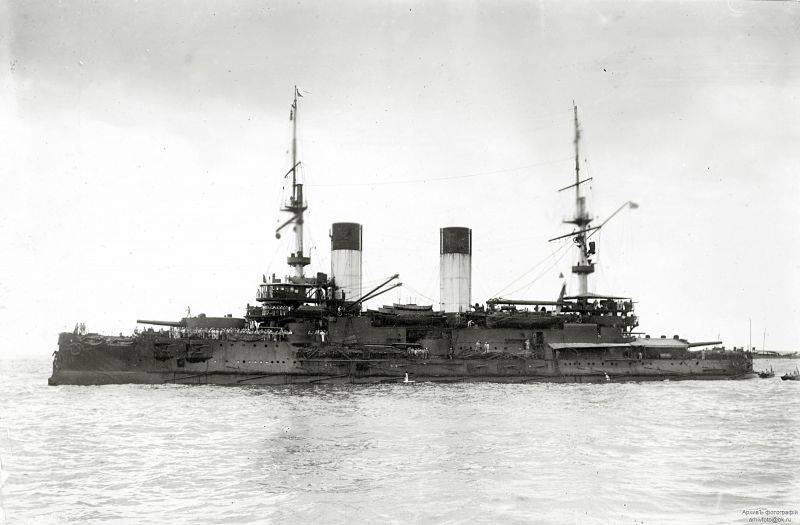
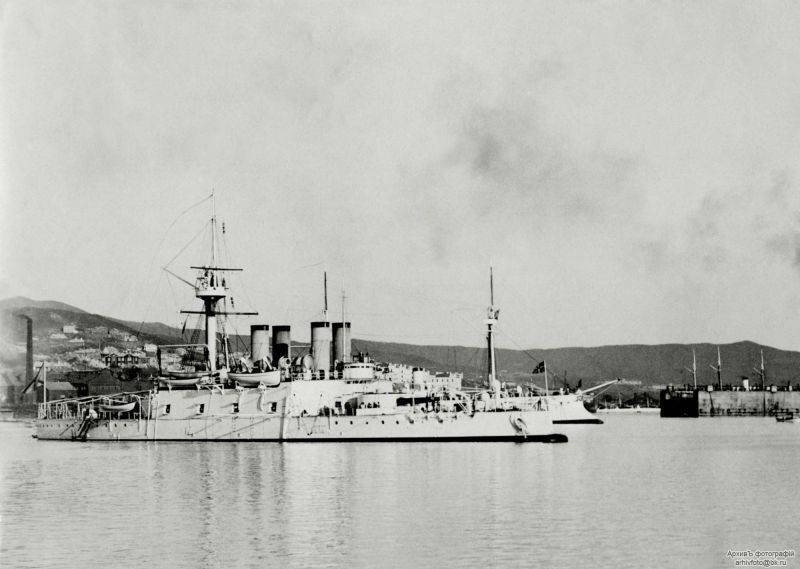
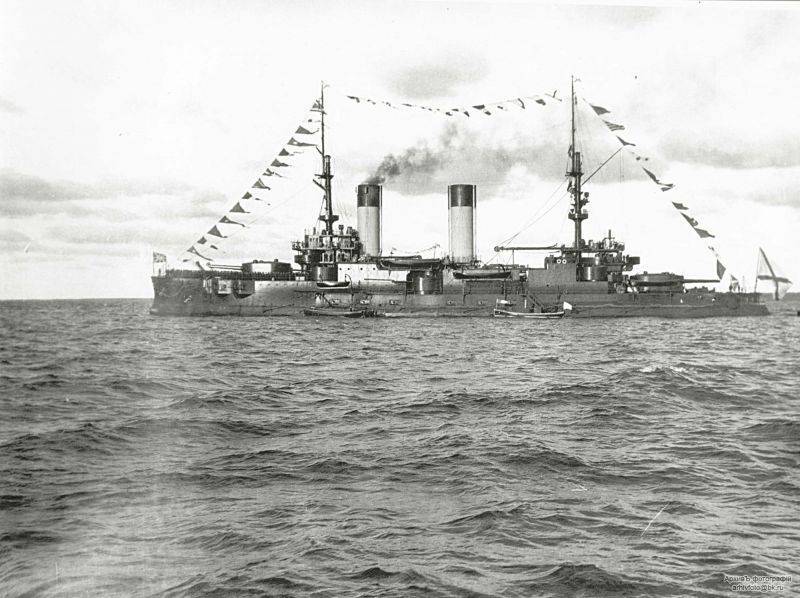
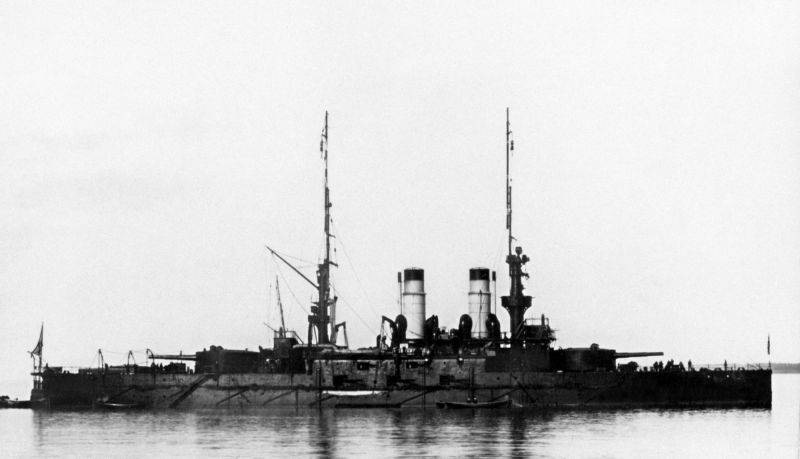
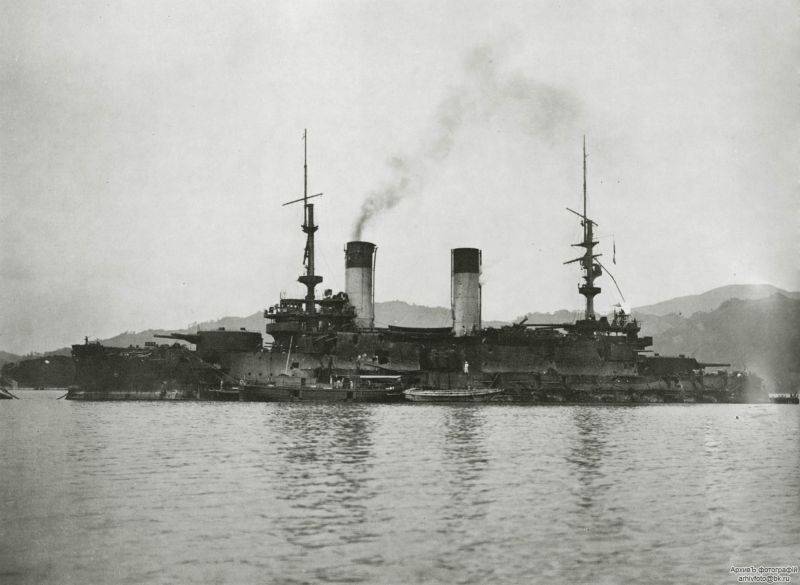
Information